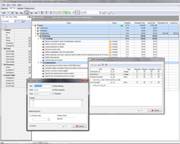|
The Monitoring phase is the final component of the business process reengineering cycle to create a closed-loop environment where performance measurements of new (redesigned) business processes establish rapport with continuous improvement. The phase entails analysis and monitoring of relevant and timely data about the processes to enable your team to track and optimize business activities. The purpose of the phase is to ensure that new processes are performed smoothly, as expected and at appropriate performance level.
The Monitoring phase can be best described as a two-step cycle that includes these components:
- Process tracking
- Process optimization
Your team can carry out the phase by dividing each of the steps into a series of simple tasks and activities that are easier to manage by using VIP Task Manager. Let’s find out what tasks can be planned for doing the steps and how VIP Task Manager can be helpful.
 Process Tracking Process Tracking
Process tracking entails monitoring of individual activities of your redesigned process environment, so that information on their performance can be easily retrieved and examined. An example of process tracking is when your project team determines the status of a customer order (e.g. Ordered, Arrived, Invoice Paid, Awaiting Delivery), so that problems in its operation can be identified and corrected.
Process tracking addresses the following goals:
- Detecting process bottlenecks and performance gaps in real time (when a process is in progress).
- Taking prompt corrective actions to avoid process breakdowns and ensure desired performance.
- Identifying emerging risks before damage is done.
- Taking advantage of improvement opportunities as they are available.
In order to accomplish these goals, your team needs to monitor processes against such measures as cycle time, fault rate and performance. Here’re tasks to do by the team:
- Execute process tests and log any discrepancies. The team compares test results with expected results. If any discrepancy exists it is logged as "possible fault".
- Determine if a discrepancy is truly a fault. The team reviews logs and focuses on discrepancies that are marked as "possible fault". Through a failure analysis the team identifies whether the discrepancies really cause a fault to processes and whether they’re repeatable. If they don’t cause process defects, then the log should be closed with explanatory comments.
- Correct discrepancies. Your team determines reasons of process faults, or what factors cause discrepancies. The team tries to handle and correct defects. There should be a corrective action plan the team uses to handle the issues.
- Start the resolution process. This activity comes after faulty processes are detected and discrepancies are handled. Your team starts resolving the processes while trying to fit them into these measures: cycle time, defect rate and productivity. If the team reaches tolerance of the measures, the processes can be regarded as resolved.
The tracking activity results in delivering corrected and resolved processes. Meanwhile, further development of these processes requires optimization because otherwise there is likelihood that the processes become faulty and inconsistent again. The next activity of the Monitoring phase should ensure process optimization.
Process Optimization
Optimization of corrected processes starts with an attempt to analyze issue logs and review corrective actions applied. The purpose is to detect process bottlenecks and then develop a model for optimizing processes.
Processes can be optimized at the following levels:
- Activity level. It covers rules of managing tasks, procedures and workflows of processes. Your project team needs to determine faulty process components and then design a plan that prevents faults and discrepancies in the future.
- Functional level. Functional optimization level means looking at functions and capabilities of redesigned business processes to assess performance and availability of these processes. The purpose is to explore whether your processes have a potential for optimization, regardless of performance measurement and instances.
- Technical level. IT infrastructure and tools should be reviewed for faults and then optimized by resolving any faults revealed. The team should identify whether reengineering opportunities and enabling technologies were realistic and sufficient for reaching process optimization.
Using VIP Task Manager
The two activities of the Monitoring phase can be divided into a range of tasks to be planned and managed with help of VIP Task Manager. Your team can use the software to design checklists and templates. For example, the following checklist can be created to manage tasks of the Monitoring phase:
- Monitoring Phase
- Tracking
- Execute process tests
- Log discrepancies revealed
- Analyze logs and records
- Define discrepancies
- Define repeatability rate of process faults
- Make a corrective action plan
- Define optimized cycle time, expected tolerant defect rate and desired productivity for processes
- Resolve processes in terms of optimization measures
- Optimization
- Use issues logs to analyze status of identified issues
- Review corrective actions applied
- Determine if there’s a need to initiate more actions for solving any open issues
- Detect process bottlenecks that block process optimization
- Identify the activity level and its content
- Identify the functional level and its content
- Identify the technical level and its content
- Create a model of process optimization based on the three levels
- Engage the team in using the model to continuously monitor processes and adjust them if required
- Schedule regular processes checks and audits to ensure process optimization.
|